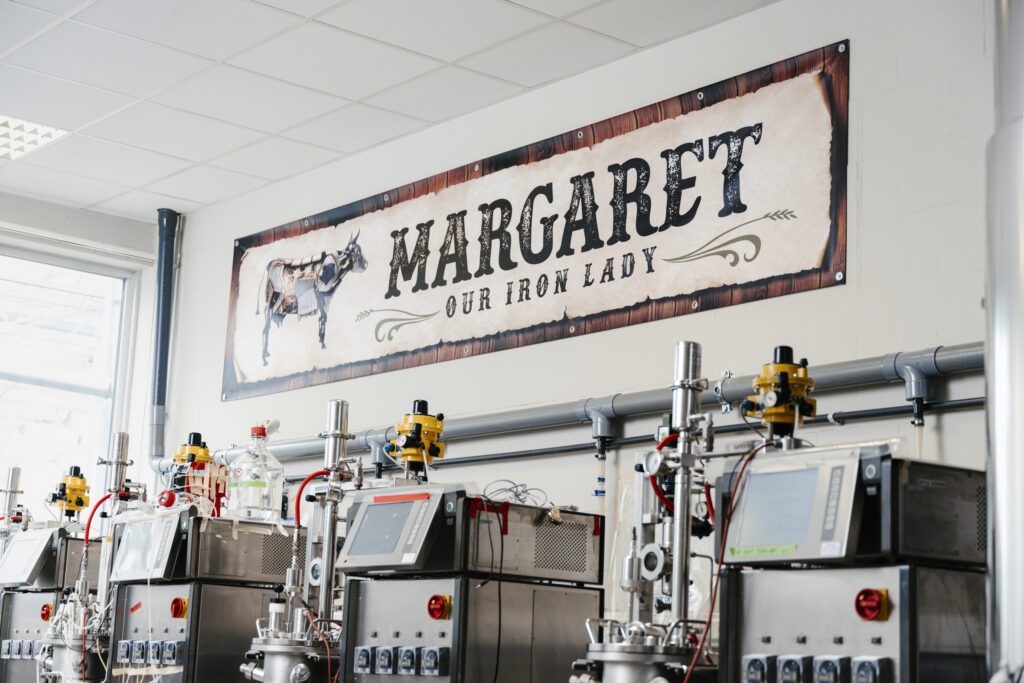Exclusive: Think Tank Shows How Governments Can Create National Protein Transition Strategies
9 Mins Read
Devising a national action strategy for alternative proteins is crucial for countries’ climate targets and global food security – a new report shows how.
In the next 25 years, the world will need 56% more food to feed its expanding population. But it has never faced a worse threat to food security than it does now, with current dietary patterns wreaking havoc on the planet, and climate change returning the favour in the worst possible ways.
Extreme weather events are decimating crop health, at a time when one in 10 people are undernourished. At the rate we’re going, the food system is simply not sustainable enough, either for a population that will be approaching 10 billion by mid-century, or for the planet it inhabits.
This is because the food system alone produces a third of all greenhouse gases, takes up 70% of the world’s freshwater, and is responsible for 80% of global deforestation. Agriculture also occupies nearly half of all habitable land – but 80% of this is attributable to livestock, which only accounts for 17% of our calorie supply, and 38% of protein consumption.
It’s why many companies are hoping to reshape the food system with future-facing, planet-friendly options, whether it’s plant-based food, cultivated meat, or fermentation-derived proteins. This industry – collectively called alternative protein – has made tremendous strides in the last decade or so, but it needs help.
Help from the public sector, that is. The meat and dairy industries are heavily subsidised by governments across the world, but alternative protein companies see a fraction of the same capital. To truly effect change, and actually make a bid to reach their 1.5°C targets (however unlikely this goal now may be), policymakers need to develop national strategies to propel this industry forward.

“Considering the vulnerabilities in today’s highly centralised global food system – where pandemics, geopolitical crises, and environmental disasters can have far-reaching impacts – a national plan that advances protein diversification helps envision a more resilient, future-ready food supply,” says Alla Voldman, VP of strategy and policy at the Good Food Institute (GFI) Israel.
The alternative protein think tank has worked with Monitor Deloitte to produce a three-step guide for governments across the world to adopt a national action plan for alternative proteins – whether that’s as a standalone approach, or a pillar within existing agrifood or bioeconomy strategies.
Voldman says such national plans help countries ensure their alternative protein progress aligns with broader national priorities and creates synergy across sectors and stakeholders. “This alignment fosters stability, especially in cases where short-term political shifts might otherwise divert resources or support away from long-term food security strategies,” she tells Green Queen.
She adds that these strategies enable greater inclusivity of countries with valuable infrastructure and resources and thus promote global cooperation: “Moreover, such action plans signal to the private sector that the government supports alternative protein development. This confidence encourages innovation, research, and investment, helping to build a robust ecosystem around alternative proteins.”
A three-step process, starting with motivation

The framework targets policy officials, food alliances and NGOs, and sustainability-focused groups that can collectively play a pivotal role in shaping national strategies.
“Given that many policymakers may lack familiarity with the alternative protein ecosystem, these organisations, which have a broader view and understanding of the sector across the value chain, can offer vital insights,” says Voldman. The local expertise of NGOs and food organisations can help tailor strategies to a country’s specific needs, which is a key goal of the report.
Explaining the three-step framework, she says: “First, it encourages viewing the issue from the government’s perspective, understanding what drives government action, and aligning the strategy with national priorities. Second, it emphasises determining the role the country could play in the global food system, leveraging regional strengths to ensure resilience.
“The final step focuses on activation – the how that is sometimes missing from the advocacy discourse—taking a bottom-up approach driven by the local ecosystem, identifying market failures, and pinpointing opportunities where government intervention can have the greatest impact.”
The first stage – the motivation behind adopting such strategies – involves a range of different factors. Countries could be compelled to do so for greater economic growth, more resilient food security, better public health, meeting growing market demand, or as a means of more progressive climate and biodiversity action.

For example, Denmark – the first country to adopt a national action plan for plant-based food – did so to speed up its green transition, becoming a trailblazer in climate-friendly food production. But for countries like the Netherlands or Singapore, the aim is to reduce reliance on food imports and boost self-sufficiency.
National motivations can range from long-term strategic plans to adapting current policies. The former would include strategies like Singapore’s digital-first Smart Nation Vision and 30 by 30 food security initiative, China’s ongoing Five-Year Plan for agriculture, or Canada’s 2030 Agenda, all of which namecheck alternative proteins.
Meanwhile, short-term policies can shape long-term ambitions. Countries could have a specific budget for food and agriculture, allocate significant funds for economic growth, and take executive action. The US is the perfect example here – it has budgets like the Farm Bill, funds such as the Inflation Reduction Act, and commitments towards biotech and biomanufacturing.
Setting up a vision and activation roadmap

When it comes to establishing a vision and assessing individual nations’ strengths and weaknesses, several factors are in play. The presence of an enabling environment determines whether there’s a foundation for economic development.
South Korea, which followed Denmark in establishing a plant-based transition plan, has focused on increasing the share of locally farmed products in its strategy. India, meanwhile is banking on its biomanufacturing capabilities to advance its smart protein sector. And nations like the UK, the US, and Singapore are host to multimillion-dollar research institutions set up by the Bezos Earth Fund.
Then there’s the market size, which provides context for the potential value alternative proteins could create domestically, and whether this fulfils the initial motivation. For instance, the US is a large market with a relatively high level of government spending available, enabling a more expansive vision for alternative proteins.
In contrast, Israel’s smaller market size means it’s better suited as an entrepreneurship and venture capital hub that can play an incubator role for research and new projects with global-scale potential. This brings us to the third dimension for establishing a vision: the innovation ecosystem. This outlines whether countries have the right blend of societal factors to help innovators who develop ideas and products, and take risks to launch new ventures.

Israel is capitalising on its role as an innovation hub by targeting the creation of hundreds of new companies, manufacturing facilities, and significant job opportunities in the alternative protein space. “This highlights how strategic support from the government can foster innovation and stimulate economic growth,” suggests Voldman.
Finally, in the activation stage, there are two primary elements for stakeholders to consider. Countries must define a call to action by identifying critical shortcomings that could hamper its alternative protein goals, as well as the government policies that can bridge these gaps.
So if there’s limited research activity and domestic spending, state-funded grants can help remedy that. And if there’s a low rate of businesses going from pilot to commercial scale, regulatory advancements – like Brazil’s nod to using meat- and dairy-related terms on plant-based packaging and the approval of cultivated meat for sale – will go a long way in shifting that trend.
Meanwhile, developing an effective communication plan to convey the benefits of a protein transition is crucial too. Many countries are doing this by highlighting the employment potential, with studies showing alternative proteins could create 25,000 jobs in the UK, 10,000 in Israel, and 17,000 in Canada.
How to overcome the challenges of adopting alternative protein policies

GFI and its partners are helping several countries across the world develop strategies to support the alternative protein industry, and is offering a free workshop to help organisations kickstart their own efforts. “There’s a growing recognition of the sector’s potential to drive economic growth, enhance food security, and address environmental sustainability, and many governments are increasingly exploring how to incorporate alternative proteins into their national policies,” says Voldman.
Collaboration between stakeholders, meanwhile, is key, says Rune-Christoffer Dragsdahl, secretary-general at the Vegetarian Society of Denmark, which helped shape the country’s action plan. “Throughout the process in Denmark, we drew inspiration from actions taken in other countries, and likewise, we hope others can be inspired by what has recently happened in Denmark and beyond,” he notes.
The report is intended as a complementary tool to ensure public investments are made in areas with the highest economic and social returns. Research suggests that if governments pump in an additional $4.4B into the R&D and $5.7B into the commercialisation of alternative proteins each year, the industry could support nearly 10 million jobs by 2050.
But several hurdles currently impeded hinder policy progress. “One key challenge is that many countries are still figuring out how to maximise their existing resources to drive investment in alternative proteins,” says Voldman. “Each country has unique strengths – whether in research and development, agricultural resources, or manufacturing capabilities – but there’s often uncertainty about how to align these assets with the growth of an alternative protein sector.”

The lack of detailed, granular gap analyses is another significant barrier. “Policymakers need a clearer understanding of the specific gaps in their country’s alternative protein ecosystem and the potential return on investment from addressing them. Without this evaluation, it may be difficult to justify allocating public funds or prioritise investments,” she says.
“Additionally, it is sometimes assumed that every country needs to build a venture capital ecosystem or become a commercial manufacturing powerhouse to succeed in alternative proteins,” Voldman adds. In reality, each country can play a different role in the global alternative protein landscape. Some may excel in research, while others focus on sustainable agriculture or supply chain innovations.
“Accepting that there are multiple ways to benefit from the growth of alternative proteins can help countries develop more realistic and effective strategies,” she says, highlighting that these challenges can be addressed by leveraging existing national assets and adopting a more tailored approach to strategy development.
Doing so is absolutely critical to the future of the planet, its biodiversity, food security, and human health. As the report puts it: “If we’re to stay within planetary boundaries, business-as-usual food production won’t cut it.”



